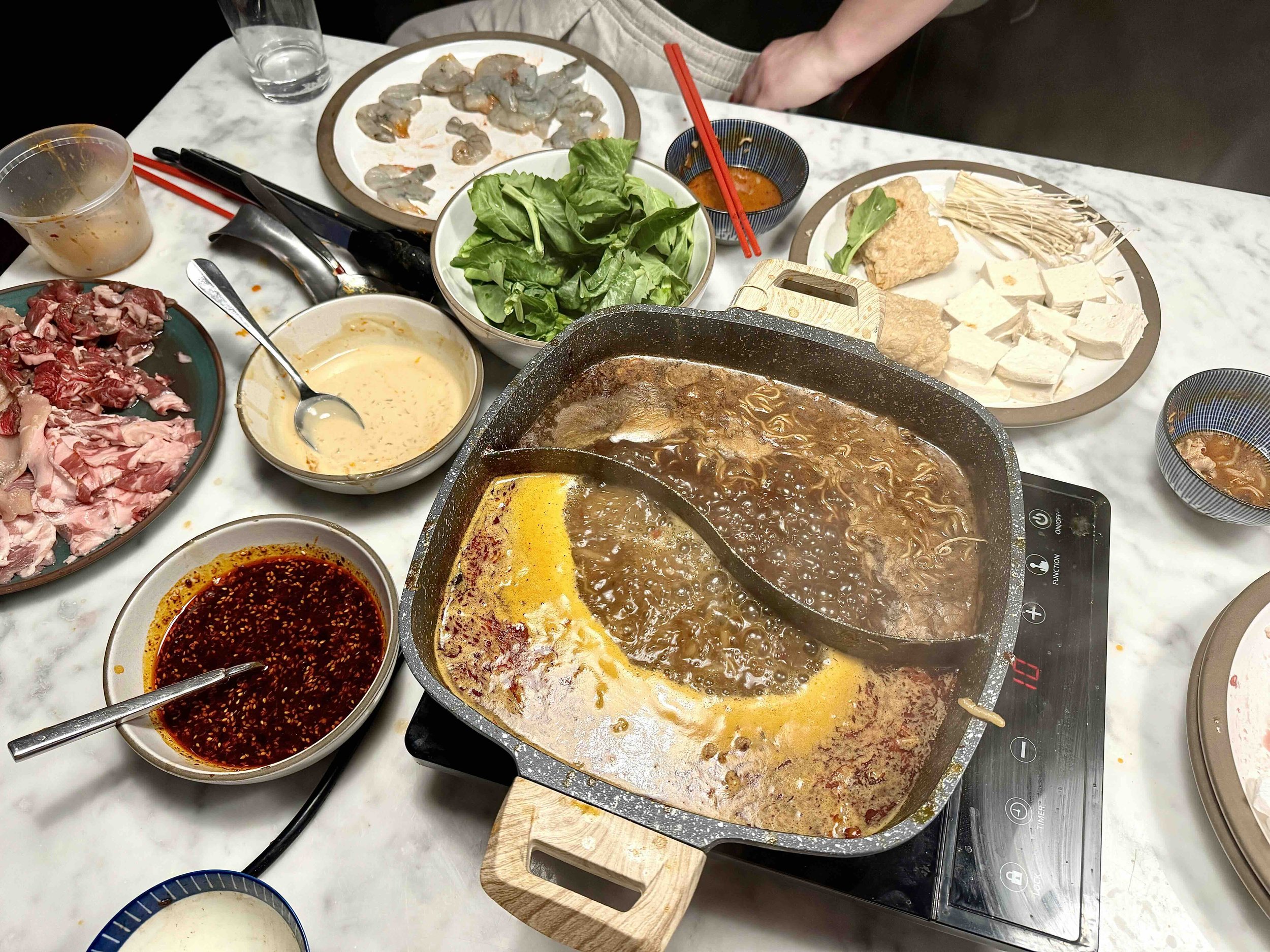A Guide to Hot Pot at Home
I use a divided hot pot setup to enjoy two different types of broth simultaneously.
A Guide to Hot Pot at Home
The third installation of Demystified: Soy Bean Paste, we’re exploring the use of Chinese fermented soybean paste in hot pot. Hot pot is a beloved tradition, especially in Northern China, and has found its way into many other Asian culinary traditions. There’s the Japanese shabu shabu, centered around a miso-flavored broth; Vietnamese lẩu, with a broth enriched with lemongrass; and Korean jeongol, a communal meal cooked at the table. At the heart of Chinese-style hot pot meal sits a boiling broth, surrounded by an array of proteins, vegetables, noodles, and other accompaniments. Guests are invited to immerse their favorite ingredients into the broth, letting them cook for just a few moments or minutes.
When I make hot pot at home, I like to use two types of broth. (Definitely worth investing in a dual sided hot pot as well as a portable induction stove). One is a spicy Chongqing-style, named after the sprawling city in Sichuan province, which features fermented soybean paste, doubanjiang (fermented fava bean and chili paste), prickly ash, star anise, cinnamon, and Sichuan peppercorns that give it a tingling sensation. The other is a more neutral broth with a hint of miso. Instead of buying all the individual ingredients to make the broths from scratch, since I’m already buying everything else, I take a shortcut and use a pre-made hot pot cubes. The brand I like can be found at many Asian grocery stores or on Amazon. Simply add the miso or hot pot cubes to each side of the hot pot and add water. Pro tip: I like to bring it to a full boil over my gas stove before transferring to the portable induction burner.
What goes into the hot pot is completely up to you, but most people agree that thinly sliced beef is a must. You can buy pre-sliced meat at most Asian grocery stores, or slice it at home by freezing a piece of ribeye, short rib, or chuck (for a budget-friendly option) for an hour and then slicing it thinly with a sharp knife. Other great additions include thinly sliced lamb, peeled shrimp, and squid. I would personally skip clams or mussels because if they aren’t cleaned very well, they can leach sand into the broth (party foul). Below are two recipes for traditional dipping sauces—soy and sesame paste—and a full list of suggested equipment and ingredients to make your next dinner party fun and engaging!
Special Equipment:
Ingredients for the Sesame Dipping Sauce
16 oz jar of tahini
10-15 cloves of garlic, finely chopped
2 tablespoons mirin
1 tablespoon light soy sauce
Ingredients for Soy Dipping Sauce
15 oz jar of Wan Ja Shan hot pot dipping sauce*
2 tablespoons chili crisp
*If you don’t have Wan Jan Shan dipping sauce available substitute with 1 3/4 cup regular soy sauce, 2 tablespoons of sugar, and 1/4 cup rice vinegar.
For Serving
Thinly sliced beef (ribeye, brisket, or short ribs) - Cook for 10 seconds
Thinly sliced lamb - Cook for 30 seconds
Thinly sliced pork belly - Cook for five minutes
Peeled shrimp - Cook for one-two minutes
Thinly sliced squid - Cook for one-two minutes
Egg, instant, or udon noodles - Cook for five minutes
Firm or soft tofu - Cook for two-three minutes
Fried bean curd rolls or fried tofu puffs - Cook for 30 seconds
Thinly sliced shiitake or baby bella mushrooms - Cook for five minutes
Enoki or beech mushrooms - Cook for two-three minutes
Chinese spinach, chrysanthemum greens, or pea shoots - Cook for one minute
Thinly sliced bok choy or Napa cabbage - Cook for five minutes
Serves 6-8 people
Directions for Sesame and Soy Dipping Sauces
Combine the ingredients together for the sesame dipping sauce in a deli container. Mix well and set aside.
Combine the ingredients together for the soy dipping sauce in another deli container. Mix well and set aside.
Directions for the Hot Pot Broths
For the miso broth, add 1/4 cup of miso to one side of the dual hot pot, then pour in 3-4 cups of water.
For the Chongqing broth, use 2 cubes of hot pot soup base and add 3-4 cups of water.
Cover and heat the dual hot pot over high heat until it boils. Transfer it to the induction stovetop. As you cook with the broths, you might need to occasionally add more water to ensure you have enough liquid.
See above for suggested cooking times based on ingredient! This assumes that your broth is at a constant rolling boil.
